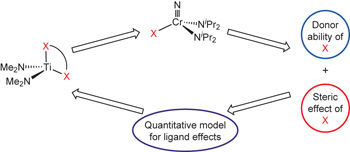当前位置:
X-MOL 学术
›
Nat. Chem.
›
论文详情
Our official English website, www.x-mol.net, welcomes your
feedback! (Note: you will need to create a separate account there.)
Quantifying ligand effects in high-oxidation-state metal catalysis
Nature Chemistry ( IF 19.2 ) Pub Date : 2017-08-07 00:00:00 , DOI: 10.1038/nchem.2843 Brennan S. Billow , Tanner J. McDaniel , Aaron L. Odom
Nature Chemistry ( IF 19.2 ) Pub Date : 2017-08-07 00:00:00 , DOI: 10.1038/nchem.2843 Brennan S. Billow , Tanner J. McDaniel , Aaron L. Odom

|
Catalysis by high-valent metals such as titanium(IV) impacts our lives daily through reactions like olefin polymerization. In any catalysis, optimization involves a careful choice of not just the metal but also the ancillary ligands. Because these choices dramatically impact the electronic structure of the system and, in turn, catalyst performance, new tools for catalyst development are needed. Understanding ancillary ligand effects is arguably one of the most critical aspects of catalyst optimization and, while parameters for phosphines have been used for decades with low-valent systems, a comparable system does not exist for high-valent metals. A new electronic parameter for ligand donation, derived from experiments on a high-valent chromium species, is now available. Here, we show that the new parameters enable quantitative determination of ancillary ligand effects on catalysis rate and, in some cases, even provide mechanistic information. Analysing reactions in this way can be used to design better catalyst architectures and paves the way for the use of such parameters in a host of high-valent processes.
中文翻译:

量化高氧化态金属催化中的配体效应
钛等高价金属的催化(IV)每天都会通过诸如烯烃聚合之类的反应影响我们的生活。在任何催化中,优化不仅要谨慎选择金属,而且还要仔细选择辅助配体。由于这些选择会极大地影响系统的电子结构,进而影响催化剂的性能,因此需要用于催化剂开发的新工具。理解辅助配体效应可以说是催化剂优化的最关键方面之一,尽管膦的参数已在低价体系中使用了数十年,但对于高价金属却不存在类似的体系。从高价铬物种的实验中得出的配体捐赠的新电子参数现已可用。在这里,我们表明新参数可以定量确定辅助配体对催化速率的影响,并且 在某些情况下,甚至提供机械信息。以这种方式分析反应可用于设计更好的催化剂结构,并为在许多高价过程中使用此类参数铺平道路。
更新日期:2017-08-24
中文翻译:

量化高氧化态金属催化中的配体效应
钛等高价金属的催化(IV)每天都会通过诸如烯烃聚合之类的反应影响我们的生活。在任何催化中,优化不仅要谨慎选择金属,而且还要仔细选择辅助配体。由于这些选择会极大地影响系统的电子结构,进而影响催化剂的性能,因此需要用于催化剂开发的新工具。理解辅助配体效应可以说是催化剂优化的最关键方面之一,尽管膦的参数已在低价体系中使用了数十年,但对于高价金属却不存在类似的体系。从高价铬物种的实验中得出的配体捐赠的新电子参数现已可用。在这里,我们表明新参数可以定量确定辅助配体对催化速率的影响,并且 在某些情况下,甚至提供机械信息。以这种方式分析反应可用于设计更好的催化剂结构,并为在许多高价过程中使用此类参数铺平道路。









































 京公网安备 11010802027423号
京公网安备 11010802027423号